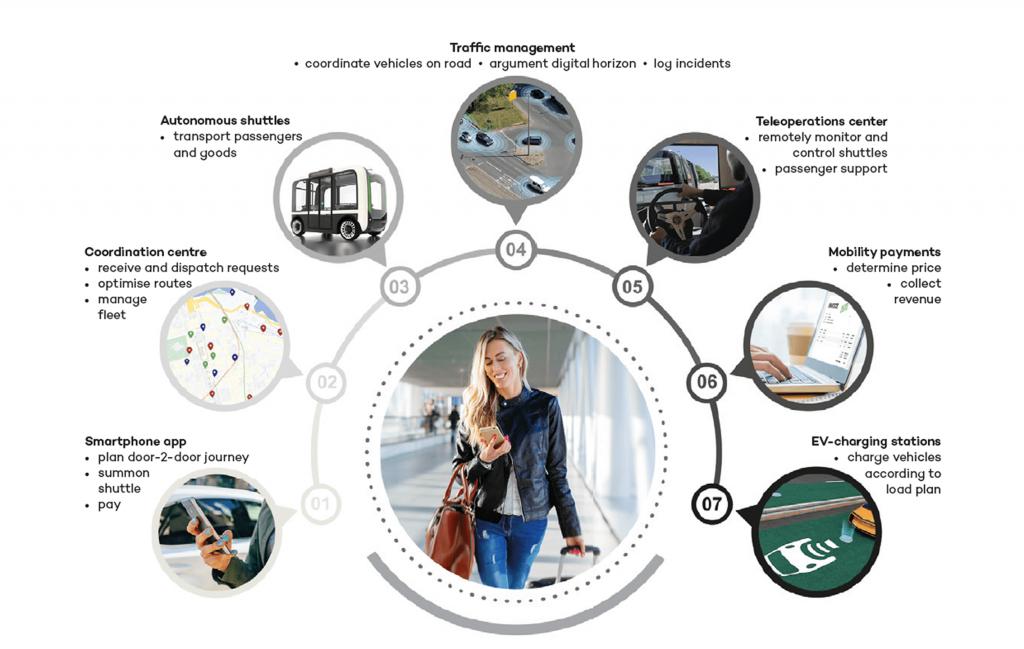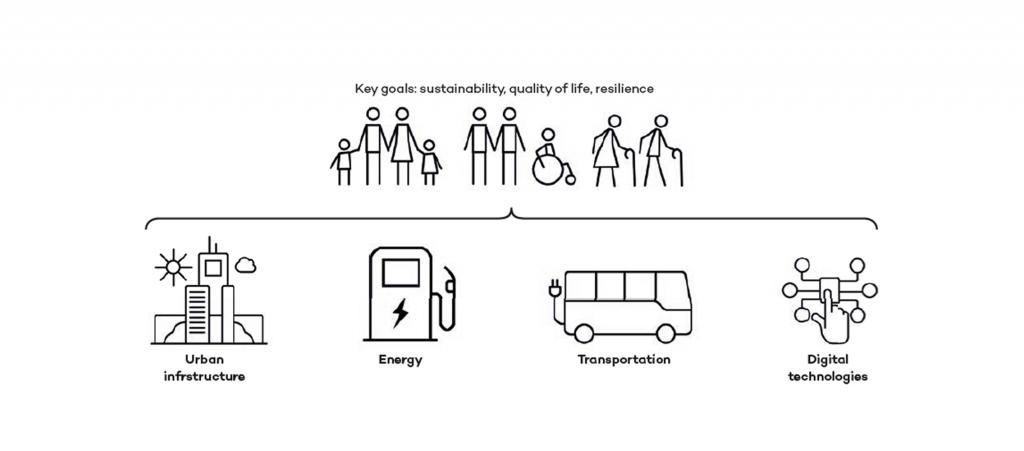
The physical and the digital city
What does digital transformation mean for a city? Under the Paris Agreement, CO2 emissions must be reduced by 50% globally by 2030 and reach net 0 by 2050. Some countries have even more ambitious plans for reductions by 2030.
The climate crisis will be solved in our cities: Urban areas occupy 5% of the planet’s surface, but account for 70% of all CO2 emissions. By 2050, 68% of the world’s population will live in cities, up from 55% in 2018. As city populations grow, demand for resources like space, energy, and water will significantly increase, as will the need for mobility. This puts a strain on many services that are essential to a city’s prosperity, sustainability, and safety. Globally, the total surface covered by buildings will double by 2060; they will be responsible for about 40% of all energy consumption. Digital technologies are fundamental to address challenges in cities. They can help for example with generating and optimising the heating and cooling of buildings with districts, thus reduce CO2 footprint.
When zooming into CO2 emissions in Europe, it becomes clear that the transport sector is one of the largest emitters and the only sector in which GHG emissions are still rising. Today, more than 95% of all vehicles use fossil fuel. This is why it is crucial that our transport systems become electrified, using renewable energies that will be coordinated through digital technologies in a smart grid. Within this environment, digital technologies will be essential for citizens individually, the economy, and the society as a whole. The reason for this is that changes in the physical world take a long time: buildings can last for many decades. Two thirds of the building stock that exists today will still exist in 2050. And passenger cars have an average lifetime of 15 years. Digital technologies, in contrast, come at much lower cost and evolve much faster. The average lifetime of a smartphone, for example, is just above 2 years. Software or machine learning algorithms can change daily. Therefore, combining urban infrastructure, buildings or vehicles, with digital technologies can make a city digitally connected and intelligent. Like any industry sector, cities are currently going through a digital transformation to adapt and prepare for their future.
Digital technologies for the city of the future.
Several digital technologies have turned out to be relevant in the context of cities (and this is not an exhaustive list):
Smartphones have become the standard interface for interactions between users and their environment. Apps allow the location of nearby bus stops or sharing vehicles and paying for them. They are used for booking a desk in the office or controlling individual light and indoor climate. They can also collect and provide a vast array of anonymised data, say for building or city operations, and thus create a feedback loop.
Wireless networks have become key for connecting people and objects ubiquitously. 5G will make a difference for many applications, however other network technologies like 4G, LTE, and WiFi will also remain important for many tasks. And there is a ‘new’ breed of low-power wide-area network protocols that are ideal for many sensor-based or smart metering applications.

Cloud computing allows for fast and inexpensive scalability, by providing endless computing resources and storage capabilities in centralised data centres, while edge computing enables local processing close to where data is captured. Combining both will be important for many applications.
The term Industrial Internet of Things (IoT) subsumes a set of technologies as well as hints at solutions that integrate sensors (or cameras) and actuators that are built into objects like roads, bridges or buildings, vehicles, or the power grid, making captured data available to back-end services as well as enabling the implementation of interdependencies.
Finally, machine learning analyses large amounts of data to learn patterns, which are then used to detect incidents, identify the need for maintenance, or anticipate future behaviour. Forecasting energy demands, air quality issues, or road congestion are some examples.

A sample solution: autonomous shuttles.
Let’s take a specific example: an easy-to-use mobility service, for which users, vehicles, transport systems, and energy systems interact to move people physically from A to B (see figure above). Digital technologies are deeply embedded in all this, controlling ‘things’ locally and connecting them with each other, building the Industrial IoT. Through initial small-scale deployments and trials of autonomous shuttles we have learned much about the complexity of the integration in these fields. This includes selecting suitable road space, integrating traffic signalling, or connectivity using stable and secure wireless networks.

Digital technologies are only a means to an end.
Digital technologies are certainly essential and required in solutions like the above, but not sufficient on their own. The real impact happens in the physical world, in the above example by transporting physical goods or people. It is important that all elements are well understood and integrated: urban infrastructure, energy, transportation, and digital technologies. All of them are very complex, separate disciplines. Understanding them individually, as well as their combination is a key point for success. Integration is about enhancing more traditional disciplines with digital technologies, across different sectors. This is not easy, and the primary reason why some of the early ‘smart city’ initiatives have failed.
The single most important point for success, though, is to understand that technologies are only a means to an end – and that for some problems ‘high tech’ is not even required. Putting the citizen or user first is, therefore, the key feature of the future city. As a very first step it must be properly understood what problem needs to be solved and for whom. With human-centred design or other design-thinking techniques, it is fundamental to explore the ‘low-tech’ options, as well as consider long-term impact and unintended consequences; and whenever possible a series of prototypes to learn quickly. With these learning processes and incremental adaptations, the result will be an user-friendly, efficient, and sustainable solution that increases the citizens’ quality of life. Regulations and business models need to support the overall purpose.
AFRY, as an expert in urban infrastructure, energy, automotive, and digital technologies, can bring all these things together. We help to build sustainable, liveable, and resilient cities. Starting with the user experience, AFRY designs sustainable, resilient, and efficient solutions that work.

